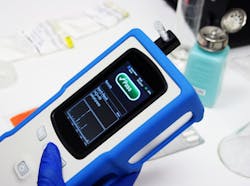Spectrometers—instruments that measure light intensity or polarization across a specific segment of the electromagnetic spectrum to analyze and identify chemical composition—range in size from tabletop to handheld. Spectroscopy has diverse application in the life sciences, including cancer detection, pathogen detection to ensure food safety, drug discovery, and point-of-care devices for remote areas of the world without access to hospital care.
"The beauty of microscopes and imaging systems is that they allow researchers to see the physical structures present in biological systems. The beauty of spectrometers is that they give us chemical information," says Brian Smith, Ph.D., spectroscopy applications specialist at Princeton Instruments (Acton, MA). "The two [biomedical imaging and spectroscopy] together are an invaluable tool in characterizing biological samples," he adds, while Ishai Nir, director of the Fluorescence Division at Horiba Scientific (Edison, NJ), notes that the pair "can measure samples on the submicron scale" and are "rapid enough to measure processes that occur on timescales ranging from femtoseconds to days."
As a result many spectrometer manufacturers are seeing an uptick in life sciences customers, particularly within the past five years. I spoke with eight different spectrometer makers, all of whom cited the life sciences as a growing market for their businesses. For example, Nir explains that for Horiba Scientific's Raman spectroscopy business, life science applications—especially outside pharmaceuticals—"are on the rise as more people in these fields discover this technique." Most of these makers were unable to share with me the percentages of their customers involved in the life sciences, but two makers cited that between 25–30% of their businesses are devoted to these customers—with room to grow.
Advantages for life sciences
"[Life sciences] applications for spectrometers all focus around one central theme: More accurate and less invasive diagnostics," says Robert Chimenti, marketing manager at B&W Tek (Newark, DE), who adds that spectrometers are ideal for these applications because they can offer high-speed, highly selective results and can be used with non-contact/non-destructive sampling techniques. For example, disease processes can be understood by comparing the spectra of healthy and diseased tissue, explains Smith.
Raman spectroscopy, "based on measuring the shift in wavelength as a low-power laser is scattered off of a sample," explains Chimenti, can be used for sample identification and quantitation, and is advantageous over other methods because it requires little to no sample preparation.1 So, Raman spectrometers enable applications such as antioxidant measurement in skin and raw material identification of active pharmaceutical ingredients (APIs) in drug identification, he says. To that end, the company's NanoRam handheld Raman spectrometer (see Fig. 1) can identify APIs in drug identification with spectral resolution (the minimum wavelength difference between two lines in the spectrum that can be distinguished) below 10 cm-1 and Raman shift (the change in wavelength of scattered light) coverage up to 3200 cm-1.
In drug discovery, a protein can be analyzed for its structure using circular dichroism spectroscopy, which refers to the differential absorption of left and right circularly polarized light2,3, thereby ensuring that the correct isomer is chosen for the particular task, explains Paul Blackborow, CEO at Energetiq (Woburn, MA).
Even though spectrometers of all sizes are useful in the life sciences market, miniature spectrometers in particular are becoming more and more popular for the fact that they are portable for use in the field, says Jason Pierce, director of business development at StellarNet (Tampa, FL), allowing "researchers to take the instrument to the sample, rather than vice-versa," says Nir. Driven by miniaturized light sources, optical components, and optical fibers to serve as light guides, "miniature spectrometers are enabling applications only dreamed about," states Eric Bergles, VP, sales & marketing at BaySpec (Fremont, CA), who agrees that miniature spectrometers will enable point-of-care solutions for combating higher healthcare costs by detecting problems earlier. Greg Neece, president at Avantes (Eerbeek, The Netherlands), adds that the ability to power these spectrometers in the field via external battery power or laptop/netbook computers is an advantage. And Ken Kaufmann, VP of marketing at Hamamatsu (Bridgewater, NJ), notes that "miniature spectrometers are being used in high-performance liquid chromatography (HPLC) instruments," which perform another method of sample analysis.
Novel achievements
"We are only at the tip of the iceberg in terms of finding out new life-saving applications utilizing 'out of lab' spectroscopic instruments," says Bergles. Neece talks about recent avian research on the Falkland Islands using Avantes' AvaSpec-2048 spectrometer: Fitted with a 2048 pixel charge-coupled device (CCD) array, the spectrometer enabled a portable setup to take directly to the seabird colonies, working from a small, 12 V battery and laptop computer. The research sought to determine the maturity level of thin-billed prions by their feather color and ornamental appearance. Because of their ability to see ultraviolet (UV) and produce signals in this range (plumage color, bill displays), spectrometers need to be used to objectively assess skin and feather colors. The data-sampling of the spectrometer they used allowed fast read-out and storage of the data (see Fig. 2)."In the U.S., over 3,000 people die every year because of food poisoning," says Bergles. To that end, spectrometers are enabling non-destructive detection of pesticides and harmful chemicals in the food system. For instance, by using BaySpec's 1064 nm Raman technology and nanoparticles, health workers are able to measure melamine in milk to ensure that it is safe to drink. A longer wavelength choice, 1064 nm excitation helps overcome fluorescence seen at lower wavelengths on most biological samples, he explains, while also performing this task at a fraction of the cost of traditional mass spectroscopy instruments. What's more, the ruggedized, no-moving-parts design enables the units to function outside of the traditional laboratory in remote dairy inspection stations in the distribution channel, he says.
High-volume life science
Pierce notes that spectrometers will continue to trend towards "miniaturization, portability, and of course cost reduction." And as operations move from low-throughput research to high-volume testing, many of the lessons of the semiconductor industry will apply: Productivity, cost-of-ownership, stability, and repeatability, states Blackborow. He adds that spectroscopic instruments for such high-volume applications will need to be more reliable, more stable, have higher uptime, lower maintenance costs, and higher throughput.
REFERENCES
1. http://www.inphotonics.com/raman.htm.
2. P. Atkins and J. de Paula, Elements of Physical Chemistry, 4th ed.. Oxford University Press, Oxford, England (2005).
3. E. I. Solomon, Inorganic Electronic Structure and Spectroscopy, Wiley-Interscience, New York, NY (April 2011).

Lee Dubay | Managing Editor
Lee Dubay is managing editor for Laser Focus World. She is a seasoned editor and content manager with 20 years of experience in B2B media. She specializes in digital/print content management, as well as website analytics, SEO, and social media engagement best practices.

